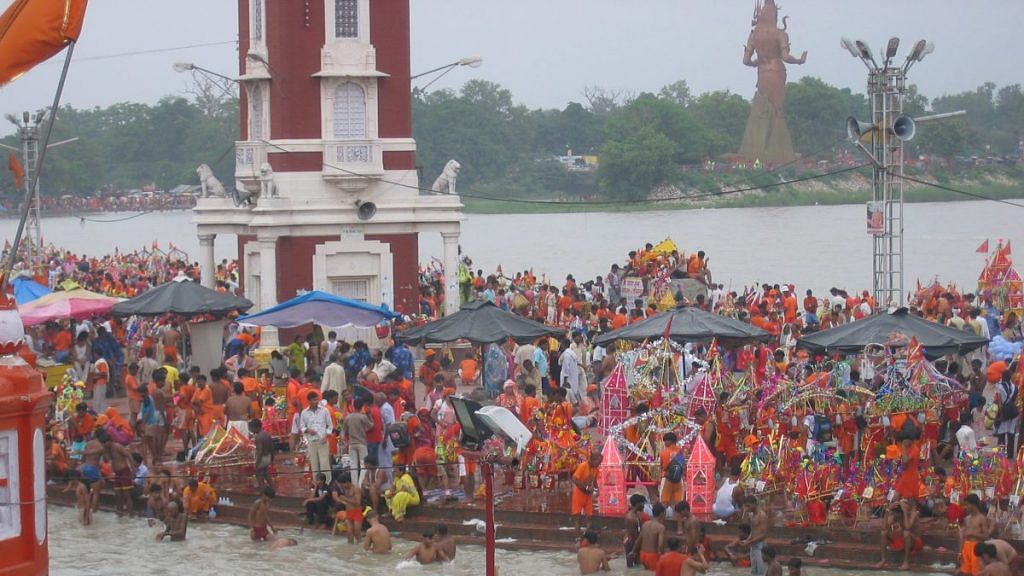The annual Kanwar Yatra is a living testament to the tradition of inclusivism in Hinduism. The northern Indian pilgrimage has its roots in the effort to neutralise the impact of venom that Shiva had consumed during the Sagarmanthan process, which turned his throat blue, or Neelkanth. But not too many have observed that the bulk of people undertaking this yatra belong to the OBC and Dalit communities.
It is an inconvenient fact for many progressive voices but the participation of Dalits and Other Backward Classes trumps the Indian liberal narrative of institutional oppression within Hinduism. This is why they fail to see that many Dalits can be followers of B.R. Ambedkar but also be devout Hindus in their personal lives.
Shiva has always had a special place in the subaltern mind. He is somehow considered a subaltern himself. This is probably why former Bihar chief minister Lalu Prasad’s disgruntled son Tej Pratap Yadav, known for his eccentric get-ups, recently posed as Shiva. His act would appeal to a large section of his party’s voters from Yadav and OBC communities. Majority of the Shaivites belong to socially backward communities, unlike the followers of Vaishnavism who usually come from a privileged section.
Diana L. Eck, the author of a seminal work on Indian culture, India: A Sacred Geography, observes, “The Story of Shiva in the land of India begins on the frontier so as to speak. He is the outsider, the mountain dweller in the far north country. Who is Shiva? In ancient India, Shiva was certainly not the “Four Vedas,” as the Tamil poet Appar put it. In fact, he is seen as outside the Vedas, Vedabhaya. He has no share in the Vedic sacrifice.”
Also read: You can be a Hindu nationalist and an Ambedkarite both
Dalits and OBCs’ proud association
The Kanwar Yatra is a grand event that brings people to Haridwar in Uttar Pradesh from all over the country. As bystanders, we notice saffron clad men and teens with gangajal in their hands during the monsoon season. Over three lakh devotees visited the city on just the first two days of the Kanwar Yatra in 2017. Last year, about 3.76 crore devotees travelled to Haridwar for the holy water, and officials say the numbers are only likely to go up this year. Food, shelter and special traffic arrangements are done by the Yogi Adityanath government while several organisations volunteer to make devotees’ journey convenient.
The sheer festivity around the Kanwar Yatra creates an ecosystem that attracts multiple stakeholders, and they all benefit and survive harmoniously for the duration of the yatra.
Take, for example, Shyam Kumar Paswan. Shyam is a 13-year-old boy, who is forced to work as a cook in a hostel in Patna because of abject poverty back home in Muzaffarpur. The mention of Kanwar Yatra fills him with joy. Shyam is a Dalit and an equally, if not more, ardent Hindu than a janeu-wearing priest in a Madurai temple. He expresses his disappointment over the government’s restriction on the use of loudspeakers, and says he won’t consume meat during the Kanwar Yatra period. When asked about the conflict of caste-based stratification in Hinduism and how he practises his faith, Shyam said, “We worship Shiva and Hanuman, who are not pretty gods like Krishna and Vishnu.”
Going on a pilgrimage to Haridwar as a kanwariya is a matter of pride for people like Shyam. A large section of the socially-backward population has been systematically kept away from the older structures of power and influence – both in religion and politics. They see Kanwar Yatra as a way to articulate their faith and commitment to the culture that is inclusive. From collecting Gangajal in Haridwar to bestowing it on their favourite god Shiva in the temple in their villages and neighbourhoods – the entire process seemingly provides spiritual redemption from the daily chores of everyday, mundane lives.
Also read: Kanwariyas vs Namazis: Double standard over disruption in public spaces?
Scholars’ duty to highlight change
Kanwar Yatra exposes the glaring falsehood in the ‘atrocity narrative’, which imagines the Dalits and the Muslims in the same category of perpetual victimhood. Over the last seven decades, Dalits have been treated as a political commodity and as someone who must be patronised. The institutions of power that perpetuated hierarchy and oppression were closely guarded by a microscopic section of political elites, and aided by academics with ulterior motives. Dalits in Bihar, Uttar Pradesh and elsewhere in the northern India are fearlessly celebrating the culture and the festivities associated with those regions.
Scholars and liberal activists continue to study the dominance of Hindu religiosity and the rise of Hindutva as antithetical to Dalit communities. This has never been tenable empirically, and less so now. Dalits are assertive Hindus. They are at the forefront of celebration during regional festivals, like during Chhath in Bihar. Paradoxically, the so-called neo-Dalit intellectuals deride them for their enthusiasm and participation, becoming rebels without a cause.
A demographic study and analysis must be undertaken by the scholars of social anthropology to highlight the ever-increasing participation of Dalits and socially-backwards in the large cultural canopy of Hinduism. If scholars readily point out that there is no one way to read the Ramayana (as they did on A.K. Ramanujan’s essay), then they must also honestly acknowledge that the Hindu culture attracts diverse communities because of these multiple narratives.
The author is a Fellow at India Foundation and Assistant Professor at Patna University. He is a member of the state executive committee, Bharatiya Janata Yuva Morcha, BJP’s youth wing, Bihar. Views are personal.
